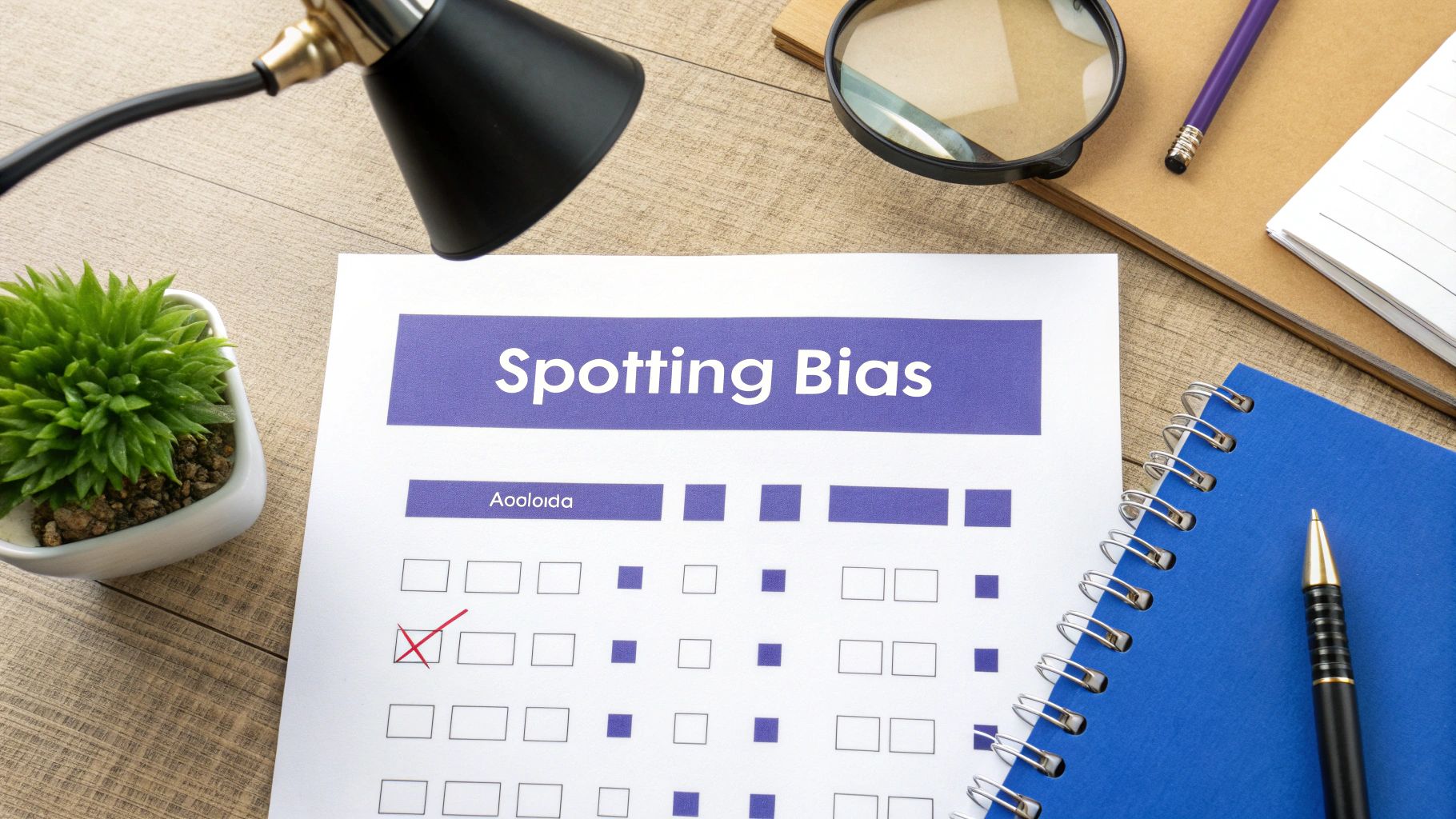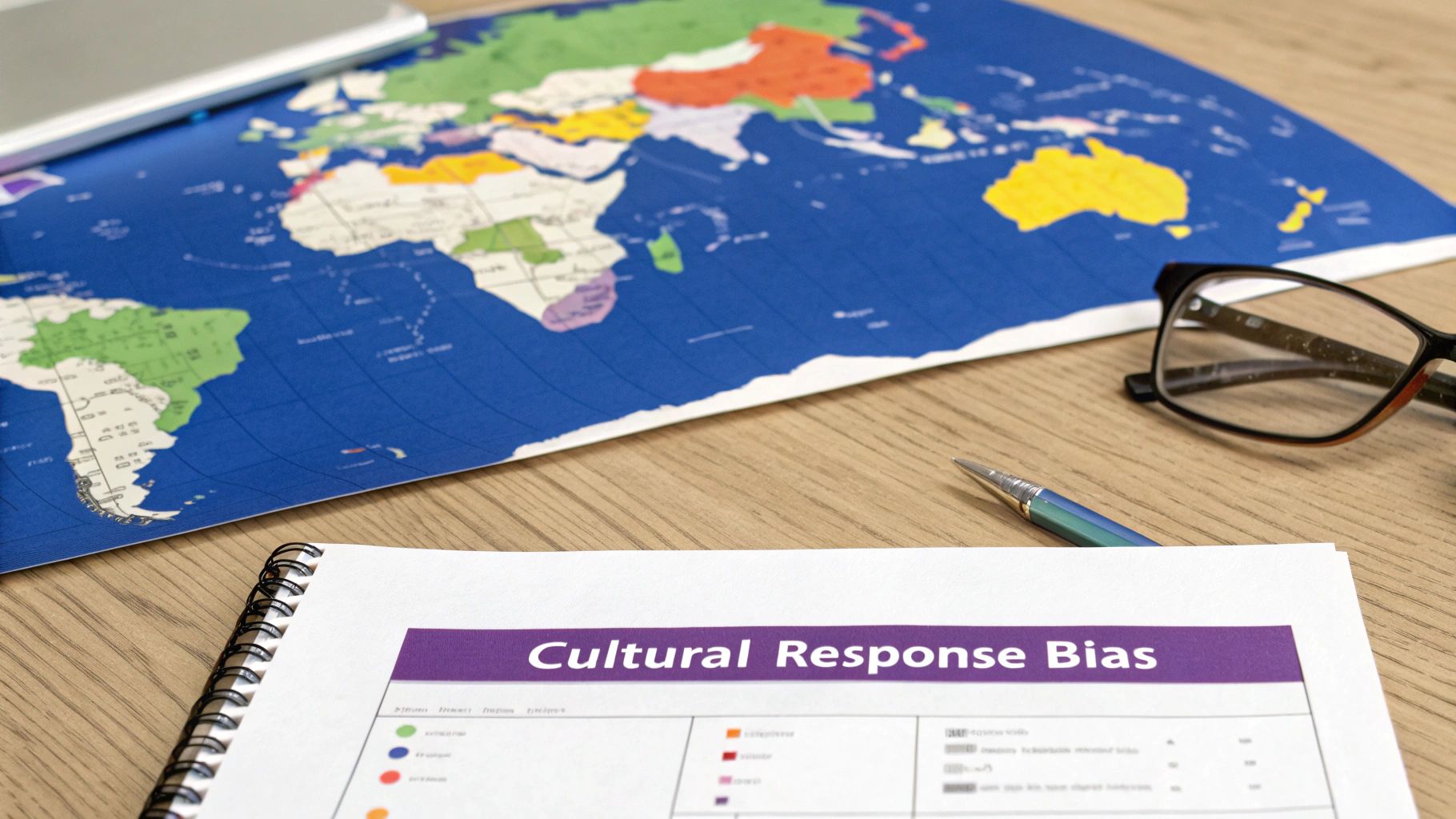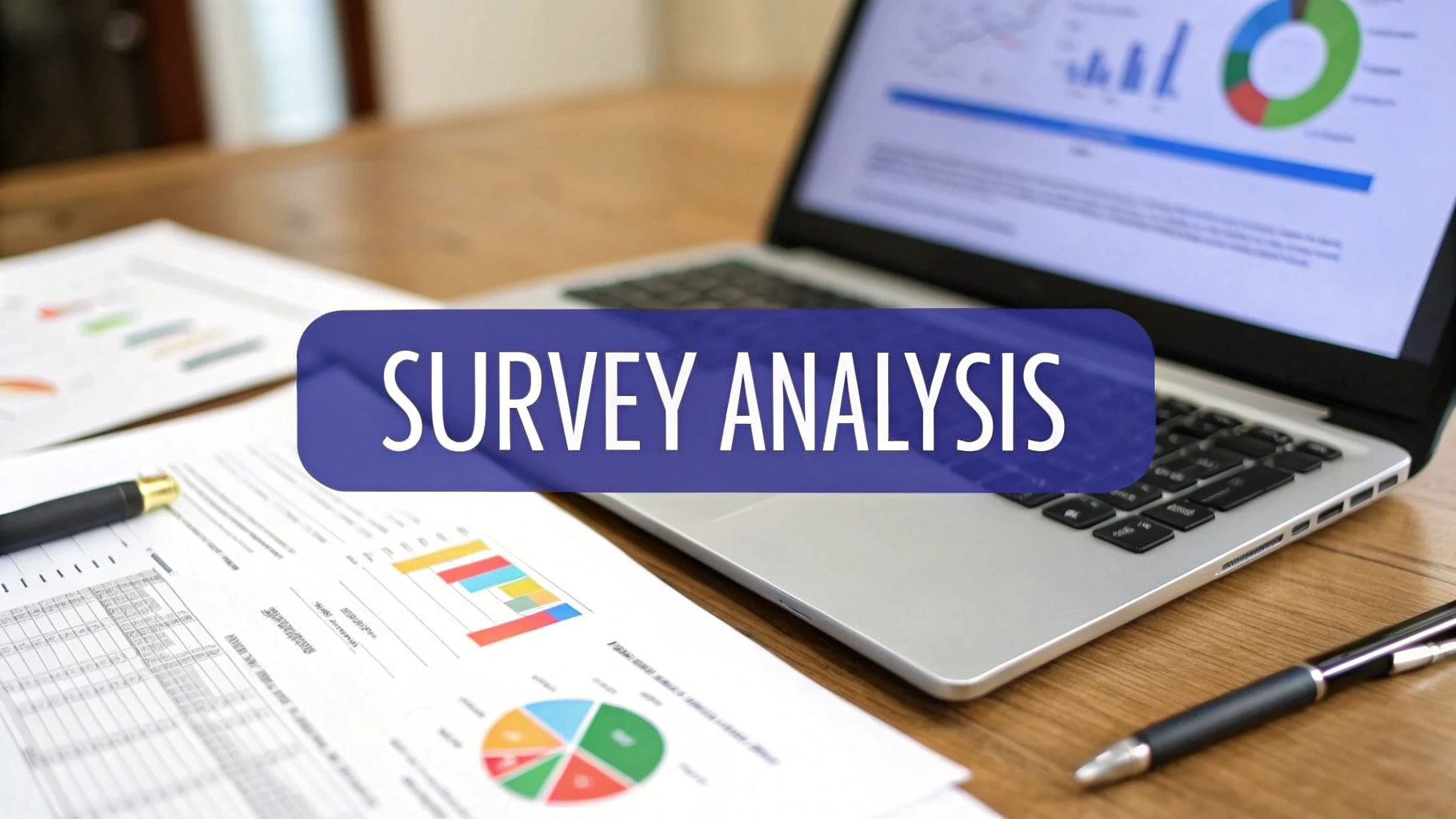Spotting Bias in Survey Questions to Get Clear Data
Learn how to identify and remove bias in survey questions. Our guide offers practical examples and techniques to create fair surveys for reliable data.

Have you had the feeling that your survey results don't quite match reality? That the "data-driven" decision you just made was based on a lie? It happens more often than you would think, and the culprit is usually survey question bias.
In short, survey question bias is when the way you ask a question subtly (or not-so-subtly) nudges people toward a certain answer. It’s like a loaded question in a courtroom where the answer is baked right in.
What Is Survey Question Bias and Why It Matters
Think of it like a faulty compass. You think you're heading north, but the compass is off by 20 degrees. You'll end up somewhere, but it won't be where you intended to go. When your survey questions are biased, they become that faulty compass, pointing your entire strategy in the wrong direction.
Even tiny tweaks in wording can completely skew your results. What should be an objective look at customer sentiment can turn into a reflection of your own hopes and assumptions. When your questions are flawed, so is every piece of data you collect.
For a SaaS company, this can be catastrophic. It could mean pouring months of engineering effort into a feature nobody actually wants, completely misreading why customers are churning, or launching a marketing campaign that falls flat. You might think you're making smart, data-backed moves, but you're really just acting on bad intel.
The Real Cost of Inaccurate Data
Let's be clear: this is about more than getting slightly off numbers. Biased data has a direct, painful impact on your bottom line. We’re talking about:
- Wasted Resources: Countless hours and dollars spent developing products or features based on a mirage of customer demand.
- Poor Product-Market Fit: You cannot solve your users' real problems if you fundamentally misunderstand what they are.
- Failed Marketing Initiatives: Campaigns built on a shaky foundation of flawed customer insights are doomed from the start, leading to terrible ROI.
- Increased Customer Churn: When you cannot accurately diagnose why customers are unhappy, you have no chance of fixing the underlying issues before they leave for good.
The table below shows just how easily a biased question can lead to a disastrous business decision.
How Survey Bias Impacts Business Decisions
As you can see, the way a question is framed has a direct line to the strategic choices you make. Getting it wrong is a business problem.
"Biased survey questions can lead to answers that don’t reflect what people truly think or feel. As the person creating the survey, it’s your job to make sure your questions are clear, neutral, and fair."
Recognizing the Unseen Influence
Bias isn't always a glaring mistake. It often creeps in through our own unconscious assumptions, the things we believe without even realizing it. To get a handle on this, it’s helpful to look at fields like hiring, where a lot of work has been done to develop strategies to smash unconscious bias in recruitment.
The same principles are at play in survey design. Becoming aware of these hidden forces is the first, most important step toward building surveys that deliver data you can actually trust.
Common Types of Biased Questions to Avoid
Learning to spot bias in survey questions is a lot like training your eye to see weeds in a garden. At first, everything looks green. With a bit of practice, you start to notice the subtle differences, the ones that tell you which "plants" are actually going to choke out the valuable insights you're trying to grow.
The best way to start weeding out bias is to get familiar with the most common culprits.
This infographic shows just how quickly a single bad question can poison your entire decision-making process.
As you can see, the road from a poorly worded question to a flawed business strategy is alarmingly short. Let's break down the specific types of questions that send you down that path.
Leading Questions
A leading question does not just ask for an answer; it gently nudges the respondent toward the one you want to hear. It uses suggestive language or frames an opinion as a fact, essentially asking for agreement rather than an honest take.
- Biased Example: "How much did you enjoy our amazing new dashboard?"
- Why it's a problem: The word "amazing" stacks the deck. It presupposes a positive experience, making it socially awkward for someone to disagree. They're far more likely to give you a higher rating than they would have otherwise.
- A Better Way: "How would you rate your experience with our new dashboard?"
This neutral version lets people form their own opinions without your influence. It opens the door for real feedback, good or bad, which is what you actually need.
Loaded Questions
If leading questions are a gentle nudge, loaded questions are a shove. They sneak in a hidden, and often controversial, assumption about the respondent. Answering the question at all means implicitly accepting that assumption is true.
- Biased Example: "What new features would you like us to add to improve our already industry-leading software?"
- Why it's a problem: This question forces the respondent to agree that your software is "industry-leading." It puts them in a weird spot, making it difficult to offer critical feedback without first challenging your premise.
- A Better Way: "What new features or improvements would you find most valuable?"
The better version drops the self-congratulatory baggage and gets right to the point: what the user's needs are. That’s why you’re sending a survey in the first place, right?
When you strip assumptions from your questions, you create a space for people to share what they really think. This is the important shift from seeking validation to genuinely seeking input.
Double-Barreled Questions
One of the most common mistakes out there is trying to kill two birds with one stone. A double-barreled question jams two separate ideas into a single question, which makes it impossible for someone to answer accurately if they feel differently about each part.
- Biased Example: "Was our onboarding process quick and easy to understand?"
- Why it's a problem: What if the process was quick but confusing? Or super easy, but took forever? A simple "yes" or "no" cannot capture that nuance. You're left with muddy data that you cannot act on.
- "How would you rate the speed of our onboarding process?"
- "How easy was our onboarding process to understand?"
- Biased Example: "Do you always use our search feature to find information?"
- Why it's a problem: Someone might use it almost every time, but "always" is a very high bar to clear. Answering "no" is technically correct but completely misrepresents how frequently they rely on the feature.
- A Better Way: "How often do you use our search feature to find information?" (Provide options like "Frequently," "Sometimes," "Rarely," or "Never.")
- Adapt Your Language: Do not just translate, localize. Work with localization services to make sure your phrasing, idioms, and examples feel natural and do not carry any weird or unintended meanings in the local culture.
- Use Neutral Scales: Ditch the classic "1 to 10" scale. Instead, try using descriptive options that are universally understood, like a scale running from "Very Dissatisfied" to "Very Satisfied."
- Pilot Test with a Diverse Group: Before you launch the full survey, run it by a small group of people from the different cultural backgrounds you’re targeting. Ask them point-blank if any questions were unclear, confusing, or just felt a bit off. Their feedback is gold for catching hidden biases you’d otherwise miss.
- Instead of: "What are your thoughts on the efficacy of our platform's UI/UX?"
- Try: "How easy is our platform to use?"
- Example: "How much did you enjoy our excellent customer service?"
- Example: "Where do you enjoy drinking beer?" (This assumes the person drinks beer in the first place.)
- Randomize the order of certain questions or even entire blocks of questions.
- Start with broad, general questions before you drill down into specifics.
- Save sensitive or personal questions for the end of the survey.
Splitting the question gives you two clean, specific data points. We dig into this topic with more fixes in our guide on the double-barreled question example.
Absolute Questions
Absolute questions are the ones that use words like "always," "never," "all," or "every." These black-and-white terms back respondents into a corner because life is rarely that absolute. People are often forced to give an inaccurate answer because their real behavior doesn't fit the extreme options.
This approach gives you a much more realistic scale that captures the full spectrum of user behavior, resulting in a far more accurate picture of how your features are being used.
How Cultural Differences Create Hidden Survey Bias
Have you noticed how a simple phrase can land completely differently depending on who you're talking to? What’s straightforward in one culture might be confusing, or even a little offensive, in another. This is the heart of cultural response bias, a sneaky but powerful force that can throw off your data when you’re surveying a global audience.

A one-size-fits-all survey just doesn't work. Communication styles are incredibly diverse; some cultures are very direct, while others value politeness and subtlety.
This difference has a huge impact on how people answer, especially on numeric rating scales. For example, in some cultures, giving a rock-bottom score (like a 1 out of 10) is considered rude. To be polite, respondents might steer clear of extreme answers, which can artificially pump up your satisfaction scores and hide some serious issues.
Cultural Norms in Question Design
To get genuine data from people all over the world, you have to think beyond the words on the screen and consider how they'll actually be interpreted. This often means tweaking your phrasing and even ditching standard rating scales for something more culturally neutral.
Numeric scales, in particular, are notorious for creating this kind of bias. In less direct cultures, people might gravitate toward more positive answers because higher numbers are instinctively seen as "better." One study found that simply switching to neutral scales can slash this positive response bias by as much as 10%, making your data far more reliable across different groups. You can read more about tackling cultural response bias for accurate insights on skimgroup.com.
The goal is to translate intent. A question must feel as natural and easy to answer in Tokyo as it does in Texas to produce reliable, comparable data.
Actionable Tips for Reducing Cultural Bias
Building a survey that’s sensitive to different cultures is all about being thoughtful. It requires a clear focus on respect and clarity for different ways of communicating. Here are a few practical steps you can take.
When Your Survey Sample Skews the Results
You can craft the most perfectly neutral, brilliantly worded questions, but they won't mean a thing if you're asking the wrong people. Bias in survey questions often comes from who you ask. When the people you survey don’t accurately reflect your real target audience, the data you get can be just as misleading as any leading question.
This classic pitfall is known as sampling bias. It creeps in when the group you survey is fundamentally different from the larger population you’re trying to know. The result? A warped perspective that can steer you toward some seriously flawed business decisions.
The Problem with an Unrepresentative Sample
Imagine you’re trying to gauge how people feel about a new feature you just launched. If you only send the survey to your most dedicated power users, what kind of feedback do you think you’ll get? It's going to be glowing, of course. This creates an echo chamber, confirming what you were hoping to hear while completely ignoring the struggles or indifference of a much broader slice of your user base.
That's sampling bias in a nutshell. You've hand-picked a group that isn't truly representative, and now your results are skewed. To get the real story, you need to make sure your sample includes a healthy mix of all your user types. You can get a better handle on grouping your audience by checking out these customer segmentation examples.
When People Don’t Respond
Another huge issue is non-response bias. This happens when the people who do not answer your survey are systematically different from the ones who do. So even if you start with a perfectly balanced sample, a low response rate can sneak bias right back into your results.
Think about it: customers who are either extremely happy or extremely frustrated are usually the most motivated to fill out a survey. That big, quiet group of moderately satisfied users? They often do not bother. This leaves you with a polarized set of data that over-represents the extremes and completely misses the more nuanced opinions of the silent majority.
The key takeaway is that who does not answer your survey is often just as important as who does. Analyzing response patterns is important to understanding the potential gaps in your data.
Coverage Bias in the Real World
Coverage bias is a specific flavor of sampling bias where an entire segment of your target population has literally zero chance of being included in your sample. A powerful real-world example of this comes from phone surveys conducted in developing nations.
In countries like Ethiopia and Nigeria, phone surveys are a fast and common way to collect data. The problem? They overwhelmingly reach wealthier households with better living standards, simply because those are the people who own phones. This means poorer, more vulnerable households are left out entirely, leading to skewed data unless major statistical adjustments are made. The World Bank has documented these socioeconomic survey challenges in detail.
This same exact principle applies to a SaaS business. If your only method of surveying users is an in-app pop-up, you will completely miss out on feedback from churned customers or anyone who has stopped logging in. Their reasons for leaving are invisible, yet those are some of the most valuable insights you could possibly get to improve retention.
Practical Steps for Writing Unbiased Survey Questions
Knowing the different types of survey bias is one thing. Actively sidestepping them is a whole different ballgame. Moving from theory to practice means you need a clear set of habits every single time you build a survey. This is your toolkit for cutting down on bias and gathering data you can actually trust.

Let's be realistic: creating a "perfect" survey is impossible. Some level of human influence is always going to creep in. The goal, instead, is to build a repeatable process that makes your questions clearer, more neutral, and way less likely to steer your respondents. With just a few practical steps, you can drastically improve the quality of your feedback.
Use Simple and Direct Language
The absolute easiest way to inject bias in survey questions is to confuse your audience. Steer clear of industry jargon, complicated sentences, and acronyms that people outside your team won't recognize. Your questions should be so clear that they can be understood in a heartbeat.
This straightforward approach makes sure you're measuring your user's genuine experience, not just how well they can translate your corporate-speak.
Provide a Full Range of Answer Choices
Forcing someone into a choice that does not quite match their real opinion is a recipe for disaster. You end up with bad data. Always make sure you provide a complete spectrum of options, and do not forget to include a neutral or "Not Applicable" choice. This gives people an out so they aren't forced to pick an answer that isn't true just to finish the survey.
Offering a "No Opinion" or "Not Applicable" option reduces the pressure on respondents to provide an answer that may not be accurate. It respects their experience and improves the integrity of your data.
It's also worth remembering that how you deliver a survey matters. Telephone surveys, for example, are known to have low response rates, which can introduce its own kind of bias. Interestingly, though, research shows the accuracy of telephone survey data has held up pretty well over time, suggesting those biases haven't gotten significantly worse.
Always Pilot Test Your Survey
Before you launch your survey to hundreds or thousands of people, do a dry run with a small, diverse group first. Think of a pilot test as your final quality check. It's your best chance to catch awkward phrasing, confusing questions, or biased assumptions you might have missed completely.
Ask your test group for direct feedback on the questions themselves. Were any of them unclear? Did any of them feel like they were pushing you toward a certain answer? This one simple step can save you from collecting a mountain of flawed, unusable information.
Getting good at writing survey questions is a skill that gets better with practice. A great way to see these principles in action is to look at well-crafted employee culture survey questions. For more on the nuts and bolts of question creation, check out our complete guide on how to write survey questions. By putting these steps into practice, you can build surveys that deliver clear, honest, and truly actionable feedback.
Common Questions About Survey Bias
Even after you get a handle on the basics of survey bias, a few questions tend to pop up again and again. Let's clear up some of the common sticking points so you can feel more confident when you're building your next survey.
What Is the Difference Between Leading and Loaded Questions?
This is a great question. At first glance, leading and loaded questions feel pretty similar, and they both definitely introduce bias in survey questions, but they mess with your data in slightly different ways.
A leading question is all about subtlety. It gently nudges a respondent toward the answer you want to hear, often by framing an opinion as a fact to get them to agree.
A loaded question, on the other hand, is built on an unverified assumption about the person answering. Just by answering, the respondent is forced to accept that the hidden assumption is true.
While both will skew your results, loaded questions are much more aggressive. They can alienate people by making them feel like you've completely misunderstood or stereotyped them. Leading questions are a softer touch but are just as bad for your data quality.
Can I Completely Eliminate All Bias from My Surveys?
The short answer? No. It's pretty much impossible to scrub every last trace of bias from your surveys. Human language is full of nuance, and our own unconscious viewpoints can easily sneak into the questions we write, no matter how careful we are.
The goal isn't perfection; it's significant reduction. The aim is to minimize bias to a point where your data becomes a reliable and valid tool for decision-making.
It helps to think of it as a process of continuous improvement rather than a one-and-done fix. If you make a habit of knowing the common pitfalls, using neutral language, testing your questions, and choosing your sample group carefully, you can make a huge dent in bias and dramatically improve your data's integrity.
How Does the Order of Questions Affect Survey Bias?
The sequence of your questions is a bigger deal than most people think. It can create something called order bias, where the context from earlier questions influences how someone responds to later ones.
For example, imagine you start a survey by asking a user about all the specific things that frustrate them about your software. If you follow that up with a general question like, "Overall, how satisfied are you with our product?" you're almost guaranteed to get a lower score than if you'd asked it first. Why? Because you've already primed them to think about all the negative stuff.
There are a few ways to get around this:
By randomizing, you help spread any potential order effect evenly across all your responses, which keeps it from systematically pulling your results in one direction.
Ready to eliminate bias and get feedback you can trust? Surva.ai gives SaaS teams the tools to create clear, effective surveys that drive real growth. Start turning user insights into action today. Learn more at surva.ai.


